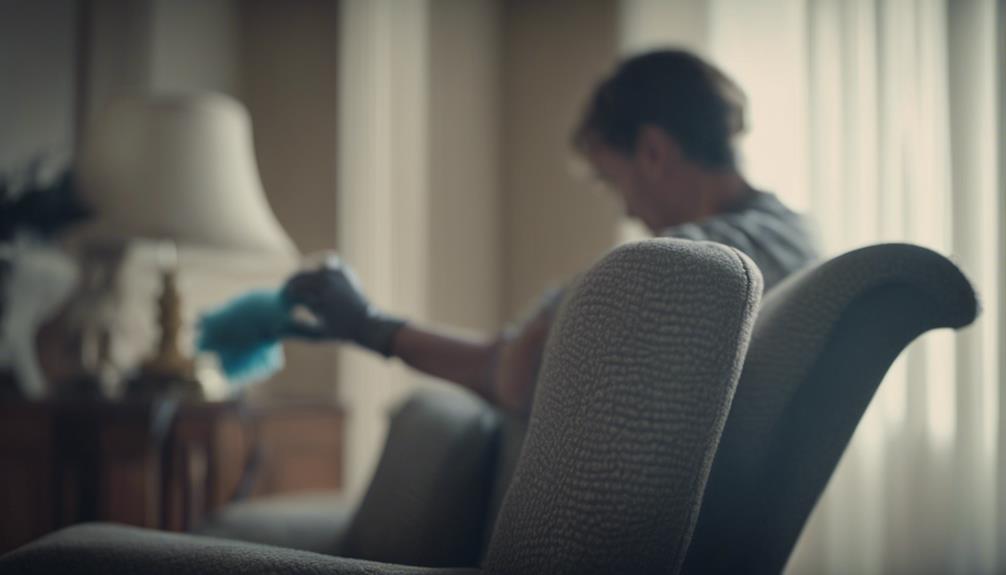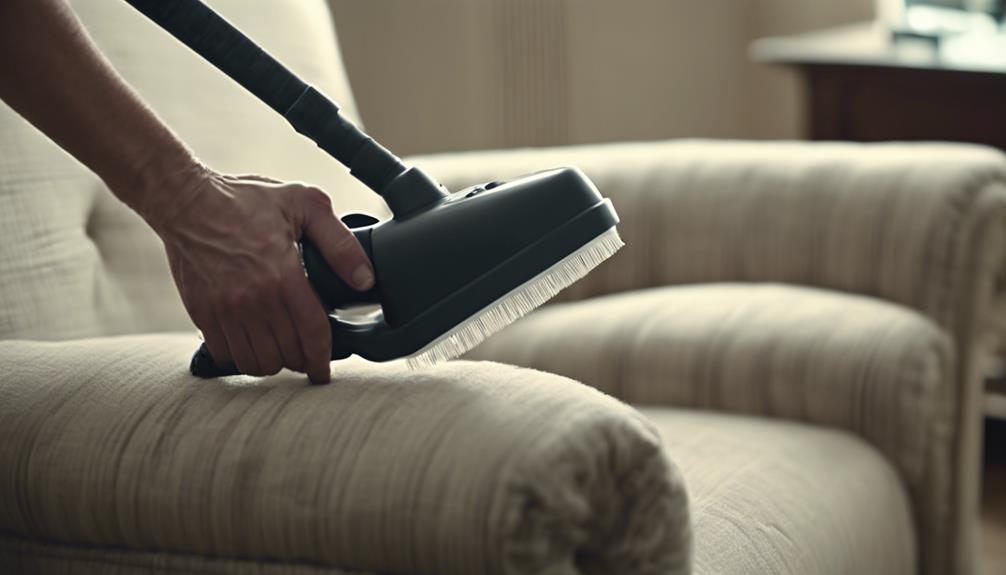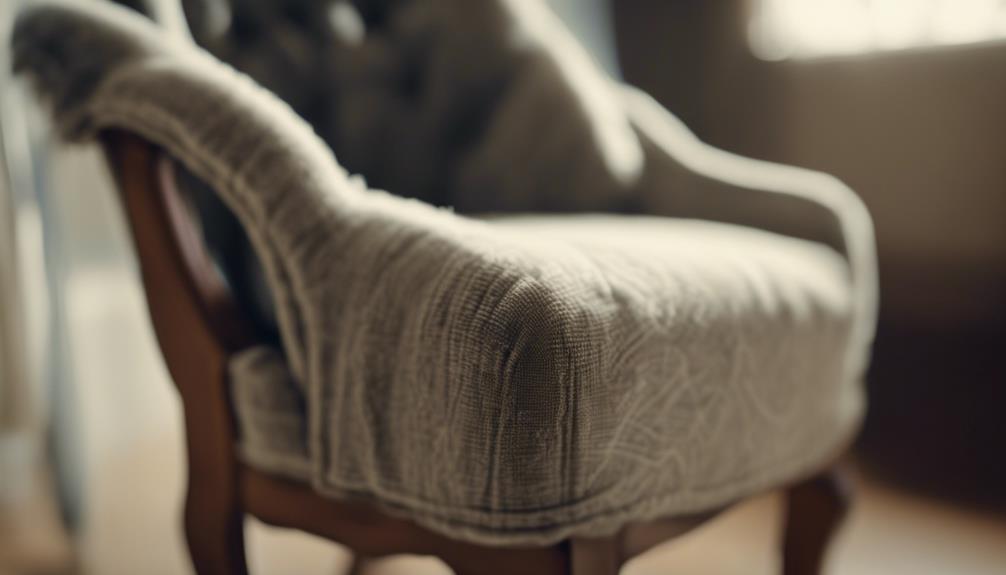To keep your upholstery chairs clean, vacuum weekly to prevent dirt buildup. Address spills promptly to avoid stains. Consider a seasonal deep clean for freshness. Understand fabric codes (W, S, WS, X) for proper cleaning. Choose suitable cleaning products based on codes. Use gentle cleaners for stains; avoid harsh chemicals. Test DIY solutions before full use. Identify fabric codes before cleaning. Use gentle cleaners like dish soap and water. Rinse thoroughly after cleaning. Allow chairs to air dry. For more tips on upholstery chair cleaning and maintenance, follow the detailed guidelines provided.
Upholstery Chair Cleaning Frequency
For best cleanliness, vacuum your upholstered chairs weekly to prevent dirt and debris buildup. Regular vacuuming helps to keep your upholstery looking fresh and free from dust and allergens.
In case of spills or stains, it's important to address them promptly to prevent them from becoming stubborn and setting into the fabric. A quick clean-up with a gentle upholstery cleaner can often do the trick. However, for more stubborn stains or for a deeper clean, consider using a portable carpet cleaner specifically designed for upholstery.
Deep cleaning your upholstered chairs seasonally or as needed can help maintain their appearance and hygiene over time. Investing in a handheld vacuum can also streamline the process of regular maintenance, making it easier to keep your upholstery chairs looking their best with minimal effort.
Identifying Fabric Cleaning Codes
When identifying fabric cleaning codes on your upholstery chairs, it's important to understand the symbols like W, S, WS, and X.
These codes provide guidance on the appropriate cleaning methods and products for each specific fabric type.
Knowing the cleaning code guarantees effective and safe cleaning without risking damage to your upholstery.
Fabric Cleaning Codes Overview
To effectively maintain the quality of your upholstery chairs, understanding fabric cleaning codes is vital. Fabric cleaning codes such as W, S, WS, and X provide specific instructions on how to clean different types of upholstery fabrics. These codes serve as guidelines to help you choose the appropriate cleaning methods and products to keep your upholstery chairs looking their best.
Each code indicates whether water-based cleaning, solvent-based cleaning, or professional cleaning is recommended for the fabric. By following these fabric cleaning instructions, you can prevent damage and guarantee effective cleaning of your upholstered furniture. It's essential to adhere to the recommended cleaning methods based on the fabric code to prolong the lifespan of your upholstery chairs and maintain their fresh and clean appearance.
Understanding and following fabric cleaning codes will help you preserve the quality of your upholstery for years to come.
Understanding Code Symbols
Understanding code symbols on upholstery chairs is key to identifying the appropriate fabric cleaning methods. Fabric cleaning codes such as W, S, WS, and X provide crucial information on how to best clean different upholstery fabrics.
Each code signifies specific cleaning instructions tailored to maintain the quality and appearance of the upholstery. By checking the cleaning code before starting the cleaning process, you guarantee that the proper cleaning method is employed, reducing the risk of damage.
Following these fabric cleaning codes not only helps in selecting the right cleaning products but also guides you in using the proper cleaning techniques for effective upholstery maintenance.
Stain Removal Techniques

Consider using a gentle upholstery cleaner or a homemade solution to effectively tackle stains on your chairs. For water-based upholstery, create a mixture of warm water and dishwashing liquid to clean stains. Apply the solution to the stained area and gently blot with a clean cloth.
If dealing with tougher stains, spot treat using hydrogen peroxide. Before applying any cleaning solution, remember to test it on a hidden area of the chair to safeguard against damage to the fabric.
After treating the stain, rinse the area thoroughly with clean water to eliminate any remaining residue and to prevent any potential damage. Following these stain removal techniques can help keep your upholstery chairs looking fresh and clean.
Creating DIY Cleaning Solutions
You can easily create DIY cleaning solutions for your upholstery chairs using common household items like dish soap and hydrogen peroxide.
These homemade mixtures offer natural alternatives to commercial cleaners and can be just as effective.
Homemade Cleaning Mixtures
To effectively clean upholstery chairs at home, consider creating your own DIY cleaning solutions using common household ingredients.
For water-based fabrics, mix dishwashing liquid with warm water to create a homemade cleaning solution.
If you have solvent-coded upholstery, a mixture of dry cleaning solvent and warm water can be used instead.
Before applying the homemade cleaning mixtures to the entire upholstery, it's crucial to test them on a small, inconspicuous area to verify compatibility.
Adjust the concentration of the cleaning solution based on the fabric type and the level of soiling present on the upholstery.
Homemade cleaning mixtures not only offer a cost-effective solution but also provide an efficient way to clean upholstery chairs effectively.
Taking the time to create your own cleaning solutions tailored to your upholstery can lead to great results while saving you money.
Natural Ingredient Options
For a natural and eco-friendly approach to cleaning upholstery chairs, consider incorporating ingredients like vinegar, baking soda, and essential oils to create your own DIY cleaning solutions.
Vinegar is excellent for breaking down stains and odors, while baking soda helps absorb odors and freshen the fabric.
Essential oils such as lavender or tea tree oil not only add a pleasant scent but also provide antibacterial properties to your cleaning solution.
By mixing these natural ingredients with warm water, you can make an effective and environmentally friendly upholstery cleaning solution.
These DIY mixtures are gentle on fabrics, safe for pets and children, and serve as eco-conscious alternatives to commercial cleaners.
Embracing natural ingredients in your DIY upholstery cleaning can't only keep your chairs looking fresh and clean but also contribute to a healthier indoor environment for you and your family.
Application Techniques and Tips
Begin by creating a DIY upholstery cleaning solution by mixing dishwashing liquid with warm water for water-based fabrics. This important cleaner can effectively lift stains without harming the fabric of your Upholstered Chair.
Before applying the solution, test it on a hidden area to make sure it won't damage the upholstery. Once confirmed, use a soft brush or cloth to apply the cleaner to stained areas. Gently scrub in a circular motion to work the solution into the fabric.
After cleaning, rinse the upholstery with clean water to remove any remaining residue. This step is vital to maintain the fabric's integrity and prevent any potential damage.
Remember, for dry cleaning solvent upholstery, always follow the manufacturer's instructions or seek advice from a professional cleaner.
Proper Upholstery Cleaning Method

When it's time to clean your upholstered chair, the first step is to identify the fabric code to determine the appropriate cleaning method (W, S, WS, X).
For overall cleaning, use a gentle upholstery cleaner or create a solution with dish soap and water. Remember to spot treat any stains with a suitable cleaner specific to the fabric type to avoid causing damage.
After cleaning, make sure you rinse the upholstery thoroughly with clean water to eliminate any cleaning solution residue.
Finally, allow the upholstery chair to air dry completely in a well-ventilated area, away from direct heat or sunlight. This will help prevent the growth of mold or mildew.
Special Care for Microfiber Surfaces
When cleaning your microfiber upholstery chairs, it's important to use a solvent-based cleaner to avoid water marks and stains.
Avoid water or water-based cleaners to prevent damage and discoloration on the delicate surface.
Remember to gently scrub stains with a soft bristle brush and consult the manufacturer's instructions for proper care.
Microfiber Cleaning Techniques
To maintain the appearance and texture of microfiber upholstery chairs, special care is required to avoid damage while cleaning. When cleaning your microfiber chairs, opt for a gentle approach to prevent any potential harm to the material.
Regular vacuuming using an upholstery brush attachment can help remove dust and debris, keeping your chairs looking fresh. For spot cleaning, use a microfiber cloth dipped in a mild soap and water solution to gently dab at stains.
Microfiber fabric is known for its durability and stain resistance, making it a popular choice for upholstery. By incorporating these microfiber cleaning techniques into your regular maintenance routine, you can help preserve the look and feel of your upholstery over time.
Stain Removal Tips
For successful stain removal on microfiber upholstery chairs, it's crucial to handle the cleaning process with gentle care to avoid damaging the delicate fabric. When dealing with stains on microfiber upholstery, start by blotting the affected area with a clean cloth to absorb as much of the spill as possible. Avoid rubbing the stain vigorously as this can cause it to spread and set deeper into the fabric.
Create a solution using a mild detergent mixed with water, following the manufacturer's guidelines for dilution ratios. Dab the stained area with the cleaning solution using a clean cloth, working from the outside towards the center to prevent the stain from spreading further. Rinse the cloth and continue blotting until the stain lightens or disappears.
Remember to avoid using harsh chemicals or scrubbing forcefully on microfiber upholstery, as this can damage the delicate fibers. Consult the manufacturer's guidelines for specific cleaning recommendations to guarantee the longevity of your upholstered chairs.
Drying and Maintenance
Properly drying and maintaining microfiber upholstery is vital to preserve its quality and appearance over time. When it comes to drying, make sure that the upholstery is air-dried away from direct heat and sunlight. Avoid using heat sources like hair dryers or heaters, as they can cause shrinkage and damage to the fabric.
Regular maintenance includes vacuuming with a brush attachment to remove dust and debris effectively. Additionally, gently brush or wipe down the microfiber upholstery to uphold its soft texture and appearance. Following the manufacturer's guidelines for cleaning and maintenance is essential to prevent damage and extend the lifespan of your microfiber upholstery chairs.
Vacuuming Tips for Upholstery

Regularly vacuum your upholstery to effectively remove dust, dirt, and allergens.
To guarantee thorough cleaning, use a vacuum with a HEPA filter, which traps small particles and allergens.
When vacuuming your upholstery, pay special attention to crevices, seams, and cushions where dirt and debris tend to accumulate. By focusing on these areas, you can prevent buildup and keep your upholstery looking fresh and clean.
Remember to vacuum your upholstery weekly to maintain its appearance and longevity.
Regular vacuuming not only helps in removing visible debris like pet hair and crumbs but also plays a vital role in eliminating hidden allergens that can affect indoor air quality.
Incorporating vacuuming into your regular cleaning routine won't only keep your upholstery looking its best but also contribute to a healthier living environment for you and your family.
Importance of Fabric Protectors
Consider applying fabric protectors to your upholstery chairs to safeguard against stains, spills, and dirt, prolonging their lifespan and maintaining their appearance.
Fabric protectors create a protective barrier that repels liquids and prevents them from seeping into the fabric. This not only makes cleaning spills easier and more effective but also helps in maintaining the overall cleanliness and hygiene of your upholstery chairs.
By reducing the absorption of stains, spills, and dirt, fabric protectors contribute to preserving the color and texture of the fabric, guarding against fading and sun damage.
Additionally, investing in fabric protectors can save you both time and money that would otherwise be spent on frequent cleaning or professional upholstery treatments.
Avoiding Fabric Softeners

To maintain the cleanliness and integrity of your upholstery chairs, it's important to steer clear of using fabric softeners. Fabric softeners can leave residue on upholstery fabric, which not only affects the appearance and texture but also attracts more dirt and dust over time. This residue from fabric softeners may even hinder the effectiveness of stain removal products when trying to tackle spills or marks on your upholstery chairs. By avoiding fabric softeners, you can help preserve the overall look and feel of your upholstery fabric.
Instead of relying on fabric softeners, consider alternative methods like air drying your upholstery chairs or using cleaning products specifically designed for upholstery. These alternatives can help keep your chairs clean without the risk of residue buildup. Opting for air drying also allows for natural ventilation, which can help maintain the freshness of your upholstery fabric.
Make the switch to alternative methods for a cleaner and longer-lasting upholstery experience.
Maintenance Tips for Longevity
Maintaining the longevity of your upholstery chairs requires consistent vacuuming and prompt stain treatment as essential practices. Regular vacuuming helps remove dirt and debris that can wear down the fabric over time.
When spills happen, immediate stain treatment can prevent them from setting and becoming harder to remove. Additionally, consider professional cleaning at least once a year to deep clean and maintain the shape and comfort of your upholstered chairs.
Applying Scotch Guard spray can offer protection against stains and spills, while using slipcovers can provide an extra layer of defense. Avoid placing upholstery chairs in direct sunlight to prevent fading and deterioration.
It's important to follow the manufacturer's guidelines for cleaning methods and understand cleaning codes like W, S, X, and W-S to ensure proper maintenance. For tough stains, opt for non-toxic cleaning methods such as steam cleaning to prolong the lifespan of your upholstery chairs.
Conclusion
Now that you know the best way to clean upholstery chairs, keeping them looking fresh and inviting will be a breeze.
Like a gentle breeze blowing through a field of flowers, regular maintenance and proper cleaning techniques will keep your upholstery chairs looking beautiful for years to come.
So, grab your cleaning supplies and get ready to make your chairs shine like never before!